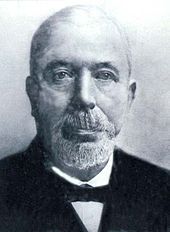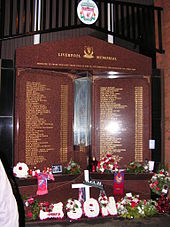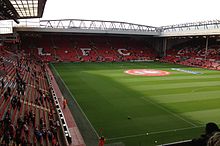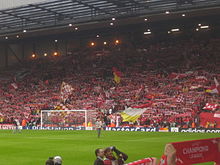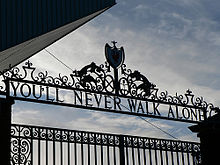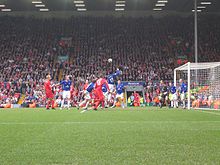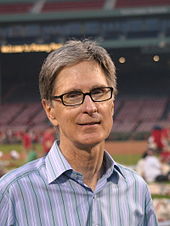
Liverpool F.C.
Background to the schools Wikipedia
SOS Children produced this website for schools as well as this video website about Africa. All children available for child sponsorship from SOS Children are looked after in a family home by the charity. Read more...
 |
||||
| Full name | Liverpool Football Club | |||
|---|---|---|---|---|
| Nickname(s) | The Reds | |||
| Founded | 15 March 1892 | |||
| Ground | Anfield (capacity: 45,522) |
|||
| Owner | Fenway Sports Group | |||
| Chairman | Tom Werner | |||
| Manager | Brendan Rodgers | |||
| League | Premier League | |||
| 2011–12 | Premier League, 8th | |||
| Website | Club home page | |||
|
|
||||
|
|
||||
Liverpool Football Club is an English Premier League football club based in Liverpool. The club has won eighteen League titles, seven FA Cups and a record eight League Cups. Liverpool has won more European titles than any other English club, having won five European Cups, three UEFA Cups and three UEFA Super Cups.
Liverpool was founded in 1892 and joined the Football League the following year. The club has played at Anfield since its formation. The most successful period in Liverpool's history was the 1970s and '80s when Bill Shankly and Bob Paisley led the club to eleven league titles and seven European trophies.
The club's supporters have been involved in two major tragedies. The first was the Heysel Stadium disaster in 1985 in which charging Liverpool fans caused a wall to collapse, killing 39 Juventus supporters and resulting in Liverpool being banned from European club competitions for 6 years. In the 1989 Hillsborough disaster, 96 Liverpool supporters lost their lives in a crush against perimeter fencing.
Liverpool has long-standing rivalries with neighbours Everton and Manchester United. The team changed from red shirts and white shorts to an all-red home strip in 1964. The club's anthem is " You'll Never Walk Alone".
History
Liverpool F.C. was founded following a dispute between the Everton committee and John Houlding, club president and owner of the land at Anfield. After eight years at the stadium, Everton relocated to Goodison Park in 1892 and Houlding founded Liverpool F.C. to play at Anfield. Originally named "Everton F.C. and Athletic Grounds Ltd" (Everton Athletic for short), the club became Liverpool F.C. in March 1892 and gained official recognition three months later, after the Football Association refused to recognise the club as Everton. The team won the Lancashire League in its début season, and joined the Football League Second Division at the start of the 1893–94 season. After finishing in first place the club was promoted to the First Division, which it won in 1901 and again in 1906.
Liverpool reached its first FA Cup Final in 1914, losing 1–0 to Burnley It won consecutive League championships in 1922 and 1923, but did not win another trophy until the 1946–47 season, when the club won the First Division for a fifth time. Liverpool suffered its second Cup Final defeat in 1950, playing against Arsenal. The club was relegated to the Second Division in the 1953–54 season. Soon after Liverpool lost 2–1 to non-league Worcester City in the 1958–59 FA Cup, Bill Shankly was appointed manager. Upon his arrival he released 24 players and converted a boot storage room at Anfield into a room where the coaches could discuss strategy; here, Shankly and other " Boot Room" members Joe Fagan, Reuben Bennett, and Bob Paisley began reshaping the team.
The club was promoted back into the First Division in 1962 and won it in 1964, for the first time in 17 years. In 1965, the club won its first FA Cup. In 1966, the club won the First Division but lost to Borussia Dortmund in the European Cup Winners' Cup final. Liverpool won both the League and the UEFA Cup during the 1972–73 season, and the FA Cup again a year later. Shankly retired soon afterwards and was replaced by his assistant, Bob Paisley. In 1976, Paisley's second season as manager, the club won another League and UEFA Cup double. The following season, the club retained the League title and won the European Cup for the first time, but it lost in the 1977 FA Cup Final. Liverpool retained the European Cup in 1978 and regained the First Division title in 1979. During Paisley's nine seasons as manager Liverpool won 21 trophies, including three European Cups, a UEFA Cup, six League titles and three consecutive League Cups; the only domestic trophy to elude him was the FA Cup.
Paisley retired in 1983 and was replaced by his assistant, Joe Fagan. Liverpool won the League, League Cup and European Cup in Fagan's first season, becoming the first English side to win three trophies in a season. Liverpool reached the European Cup final again in 1985, against Juventus at the Heysel Stadium. Before kick-off, Liverpool fans breached a fence which separated the two groups of supporters, and charged the Juventus fans. The resulting weight of people caused a retaining wall to collapse, killing 39 fans, mostly Italians. The incident became known as the Heysel Stadium disaster. The match was played in spite of protests by both managers, and Liverpool lost 1–0 to Juventus. As a result of the tragedy, English clubs were banned from participating in European competition for five years; Liverpool received a ten-year ban, which was later reduced to six years. Fourteen Liverpool fans received convictions for involuntary manslaughter.
Fagan resigned after the disaster and Kenny Dalglish was appointed as player-manager. During his reign, the club won another three League Championships and two FA Cups, including a League and Cup " Double" in the 1985–86 season. Liverpool's success was overshadowed by the Hillsborough disaster: in an FA Cup semi-final against Nottingham Forest on 15 April 1989, hundreds of Liverpool fans were crushed against perimeter fencing. Ninety-four fans died that day; the 95th victim died in hospital from his injuries four days later and the 96th died nearly four years later, without regaining consciousness. After the Hillsborough disaster there was a government review of stadium safety. The resulting Taylor Report paved the way for legislation that required top-division teams to have all-seater stadiums. The report ruled that the main reason for the disaster was overcrowding due to a failure of police control.
Liverpool was involved in the closest finish to a league season during the 1988–89 season. Liverpool finished equal with Arsenal on both points and goal difference, but lost the title on total goals scored when Arsenal scored the final goal in the last minute of the season.
Dalglish cited the Hillsborough disaster and its repercussions as the reason for his resignation in 1991; he was replaced by former player Graeme Souness. Under his leadership Liverpool won the 1992 FA Cup Final. Souness was replaced by Roy Evans, and Liverpool went on to win the 1995 Football League Cup Final. Gérard Houllier was appointed co-manager in the 1998–99 season and became the sole manager in November 1998 after Evans resigned. In 2001, Houllier's second full season in charge, Liverpool won a " Treble": the FA Cup, League Cup and UEFA Cup. Houllier underwent major heart surgery during the 2001–02 season and Liverpool finished second in the League, behind Arsenal.
Houllier was replaced by Rafael Benítez at the end of the 2003–04 season. Despite finishing fifth in Benítez's first season, Liverpool won the 2004–05 UEFA Champions League, beating A.C. Milan 3–2 in a penalty shootout after the match ended with a score of 3–3. The following season, Liverpool finished third in the Premier League and won the 2006 FA Cup Final, beating West Ham United in a penalty shootout after the match finished on 3–3. American businessmen George Gillett and Tom Hicks became the owners of the club during the 2006–07 season, in a deal which valued the club and its outstanding debts at £218.9 million. The club reached the 2007 UEFA Champions League Final against Milan, as it had in 2005, but this time Liverpool lost 2–1. During the 2008–09 season Liverpool achieved 86 points, its highest Premier League points total, and finished as runners up to Manchester United.
In the 2009–10 season, Liverpool finished seventh in the Premier League and failed to qualify for the Champions League. Benítez subsequently left by mutual consent and was replaced by Fulham manager Roy Hodgson. At the start of the 2010–11 season Liverpool was on the verge of bankruptcy and the club's creditors asked the High Court to allow the sale of the club, overruling the wishes of Hicks and Gillett. John W. Henry, owner of the Boston Red Sox and of New England Sports Ventures, bid successfully for the club and took ownership in October 2010. Poor results during the start of that season led to Hodgson leaving the club by mutual consent and former manager Kenny Dalglish taking over. After finishing in 8th position in the 2011–12 season, the worst league finish in 18 years, Dalglish was sacked. He was replaced by Brendan Rodgers.
Colours and badge
| Liverpool's home colours (1892–1896) |
For much of Liverpool's history its home colours have been all red, but when the club was founded its kit was more like the contemporary Everton kit. The blue and white quartered shirts were used until 1894, when the club adopted the city's colour of red. The city's symbol of the liver bird was adopted as the club's badge in 1901, although it was not incorporated into the kit until 1955. Liverpool continued to wear red shirts and white shorts until 1964, when manager Bill Shankly decided to change to an all red strip. Liverpool played in all red for the first time against Anderlecht, as Ian St. John recalled in his autobiography:
-
He [Shankly] thought the colour scheme would carry psychological impact—red for danger, red for power. He came into the dressing room one day and threw a pair of red shorts to Ronnie Yeats. "Get into those shorts and let’s see how you look", he said. "Christ, Ronnie, you look awesome, terrifying. You look 7ft tall." "Why not go the whole hog, boss?" I suggested. "Why not wear red socks? Let’s go out all in red." Shankly approved and an iconic kit was born.
The Liverpool away strip has more often than not been all yellow or white shirts and black shorts, but there have been several exceptions. An all grey kit was introduced in 1987, which was used until the 1991–92 centenary season, when it was replaced by a combination of green shirts and white shorts. After various colour combinations in the 1990s, including gold and navy, bright yellow, black and grey, and ecru, the club alternated between yellow and white away kits until the 2008–09 season, when it re-introduced the grey kit. A third kit is designed for European away matches, though it is also worn in domestic away matches on occasions when the current away kit clashes with a team's home kit. The current kits are designed by Warrior Sports, who became the club's kit providers at the start of the 2012–13 season. The only other branded shirts worn by the club were made by Umbro until 1985, when they were replaced by Adidas, who produced the kits until 1996 when Reebok took over. They produced the kits for ten years before Adidas made the kits from 2006 to 2012.
Liverpool was the first English professional club to have a sponsor's logo on its shirts, after agreeing a deal with Hitachi in 1979. Since then the club has been sponsored by Crown Paints, Candy, Carlsberg and Standard Chartered Bank. The contract with Carlsberg, which was signed in 1992, was the longest-lasting agreement in English top-flight football. The association with Carlsberg ended at the start of the 2010–11 season, when Standard Chartered Bank became the club's sponsor.
The Liverpool badge is based on the city's liver bird, which in the past had been placed inside a shield. In 1992, to commemorate the centennial of the club, a new badge was commissioned, including a resentation of the Shankly Gates. The next year twin flames were added at either side are symbolic of the Hillsborough memorial outside Anfield, where an eternal flame burns in memory of those who died in the Hillsborough disaster. In 2012, Warrior Sports' first Liverpool kit removed the shield and gates, returning the badge to what had adorned Liverpool shirts in the 1970s; the flames were moved to the back collar of the shirt, surrounding the number 96 for number who died at Hillsborough.
Stadiums
Anfield was built in 1884 on land adjacent to Stanley Park. It was originally used by Everton before the club moved to Goodison Park after a dispute over rent with Anfield owner John Houlding. Left with an empty ground, Houlding founded Liverpool in 1892 and the club has played at Anfield ever since. The capacity of the stadium at the time was 20,000, although only 100 spectators attended Liverpool's first match at Anfield.
In 1906 the banked stand at one end of the ground was formally renamed the Spion Kop after a hill in KwaZulu-Natal. The hill was the site of the Battle of Spion Kop in the Second Boer War, where over 300 men of the Lancashire Regiment died, many of them from Liverpool. At its peak, the stand could hold 28,000 spectators and was one of the largest single-tier stands in the world. Many stadia in England had stands named after Spion Kop, but Anfield's was the largest of them at the time; it could hold more supporters than some entire football grounds.
Anfield could accommodate more than 60,000 supporters at its peak, and had a capacity of 55,000 until the 1990s. The Taylor Report and Premier League regulations obliged Liverpool to convert Anfield to an all-seater stadium in time for the 1993–94 season, reducing the capacity to 45,276. The findings of the Taylor Report precipitated the redevelopment of the Kemlyn Road Stand, which was rebuilt in 1992, coinciding with the centenary of the club, and is now known as the Centenary Stand. An extra tier was added to the Anfield Road end in 1998, which further increased the capacity of the ground but gave rise to problems when it was opened. A series of support poles and stanchions were inserted to give extra stability to the top tier of the stand after movement of the tier was reported at the start of the 1999–2000 season.
Because of restrictions on expanding the capacity at Anfield, Liverpool announced plans to move to the proposed Stanley Park Stadium in May 2002. Planning permission was granted in July 2004, and in September 2006, Liverpool City Council agreed to grant Liverpool a 999-year lease on the proposed site. Following the takeover of the club by George Gillett and Tom Hicks in February 2007, the proposed stadium was redesigned. The new design was approved by the Council in November 2007. The stadium was scheduled to open in August 2011 and would hold 60,000 spectators, with HKS, Inc. contracted to build the stadium. Construction was halted in August 2008, as Gillett and Hicks had difficulty in financing the £300 million needed for the development.
Support
Liverpool is one of the best supported clubs in the world, with one of the highest average home attendances in Europe. The club states that its worldwide fan base includes more than 200 officially recognised branches of the Association of International Branches (AIB) in at least 30 countries. The club takes advantage of this support through its worldwide summer tours. Liverpool fans often refer to themselves as Kopites, a reference to the fans who once stood, and now sit, on the Kop at Anfield. In 2008 a group of fans decided to form a splinter club, A.F.C. Liverpool, to play matches for fans who had been priced out of watching Premier League football.
The song " You'll Never Walk Alone", originally from the Rodgers and Hammerstein musical Carousel and later recorded by Liverpool musicians Gerry & The Pacemakers, is the club's anthem and has been sung by the Anfield crowd since the early 1960s. It has since gained popularity among fans of other clubs around the world. The song's title adorns the top of the Shankly Gates, which were unveiled on 2 August 1982 in memory of former manager Bill Shankly. The "You'll Never Walk Alone" portion of the Shankly Gates is also reproduced on the club's crest.
The club's supporters have been involved in two stadium disasters. The first was the 1985 Heysel Stadium disaster, in which 39 Juventus supporters were killed. They were confined to a corner by Liverpool fans who had charged in their direction; the weight of the cornered fans caused a wall to collapse. UEFA laid the blame for the incident solely on the Liverpool supporters, and banned all English clubs from European competition for five years. Liverpool was banned for an additional year, preventing it from participating in the 1990–91 European Cup, even though it won the League in 1990. Twenty-seven fans were arrested on suspicion of manslaughter and were extradited to Belgium in 1987 to face trial. In 1989, after a five-month trial in Belgium, 14 Liverpool fans were given three-year sentences for involuntary manslaughter; half of the terms were suspended.
The second disaster took place during an FA Cup semi-final between Liverpool and Nottingham Forest at Hillsborough Stadium, Sheffield, on 15 April 1989. Ninety-six Liverpool fans died as a consequence of overcrowding at the Leppings Lane end, in what became known as the Hillsborough disaster. In the following days The Sun newspaper published an article entitled "The Truth", in which it claimed that Liverpool fans had robbed and urinated on the dead and had attacked the police. Subsequent investigations proved the allegations false, leading to a boycott of the newspaper by Liverpool fans across the city and elsewhere; many still refuse to buy The Sun more than 20 years later. Many support organisations were set up in the wake of the disaster, such as the Hillsborough Justice Campaign, which represents bereaved families, survivors and supporters in their efforts to secure justice.
Rivalries
Liverpool's longest-established rivalry is with fellow Merseyside team Everton, against whom the club contest the Merseyside derby. Their rivalry stems from Liverpool's formation and the dispute with Everton officials and the then owners of Anfield. Unlike other rivalries, there is no political, geographical or religious split between Liverpool and Everton. The Merseyside derby is usually sold out. It is one of the few local derbies which do not enforce fan segregation, and hence was known as the "friendly derby". Since the mid-1980s, the rivalry has intensified both on and off the field and, since the inception of the Premier League in 1992, the Merseyside derby has had more players sent off than any other Premier League game. It has been referred to as "the most ill-disciplined and explosive fixture in the Premier League".
Liverpool's rivalry with Manchester United is viewed as a manifestation of the cities' competition during the Industrial Revolution of the 19th century. The rivalry between the clubs intensified during the 1960s, after Manchester United became the first English team to win the European Cup in 1968, an achievement surpassed by Liverpool's four European Cup victories in the 1970s and 1980s. Manchester United started to dominate English football during the 1990s, making the rivalry all the more intense. The last player to be transferred between the two clubs was Phil Chisnall, who moved to Liverpool from Manchester United in 1964.
Ownership and finances
As the owner of Anfield and founder of Liverpool, John Houlding was the club's first chairman, a position he held from its founding in 1892 until 1904. John McKenna took over as chairman after Houlding's departure. McKenna subsequently became President of the Football League. The chairmanship changed hands many times before John Smith, whose father was a shareholder of the club, took up the role in 1973. He oversaw the most successful period in Liverpool's history before stepping down in 1990. David Moores, whose family had owned the club for more than 50 years, became chairman after Smith's resignation. His uncle John Moores was also a shareholder at Liverpool and was chairman of Everton from 1961 to 1973. Moores owned 51 percent of the club, and in 2004 expressed his willingness to consider a bid for his shares in Liverpool.
Moores eventually sold the club to American businessmen George Gillett and Tom Hicks on 6 February 2007. The deal valued the club and its outstanding debts at £218.9 million. The pair paid £5,000 per share, or £174.1m for the total shareholding and £44.8m to cover the club's debts. Disagreements between Gillett and Hicks, and the fans' lack of support for them, resulted in the pair looking to sell the club. Martin Broughton was appointed chairman of the club on 16 April 2010 to oversee its sale. In May 2010, accounts were released showing the holding company of the club to be £350m in debt (due to leveraged takeover) with losses of £55m, causing auditor KPMG to qualify its audit opinion. The group's creditors, including the Royal Bank of Scotland, took Gillett and Hicks to court to force them to allow the board to proceed with the sale of the club, the major asset of the holding company. A High Court judge, Mr Justice Floyd, ruled in favour of the creditors and paved the way for the sale of the club to Fenway Sports Group (formerly New England Sports Ventures), although Gillett and Hicks still had the option to appeal. Liverpool was sold to Fenway Sports Group on 15 October 2010 for £300m.
Liverpool has been described as a global brand; a 2010 report valued the club's trademarks and associated intellectual property at £141m, an increase of £5m on the previous year. Liverpool was given a brand rating of AA (Very Strong). In April 2010 business magazine Forbes ranked Liverpool as the sixth most valuable football team in the world, behind Manchester United, Real Madrid, Arsenal, Barcelona and Bayern Munich; they valued the club at $822m (£532m), excluding debt. Accountants Deloitte ranked Liverpool eighth in the Deloitte Football Money League, which ranks the world's football clubs in terms of revenue. Liverpool's income in the 2009–10 season was €225.3m.
Liverpool reported a £49.4m annual loss in 2011, although this figure does not include a new £25m kit deal with Warrior Sports. In the 2010/2011 season it spent €142 Mio on wages, nearly the same amount as Bayern München, and 2.5 times the amount of Borussia Dortmund.
Liverpool in popular culture
Because of its successful history, Liverpool is often featured when football is depicted in British culture and has appeared in a number of media firsts. The club appeared in the first edition of the BBC's Match of the Day, which screened highlights of its match against Arsenal at Anfield on 22 August 1964. The first football match to be televised in colour was between Liverpool and West Ham United, broadcast live in March 1967. Liverpool fans featured in the Pink Floyd song " Fearless", in which they sang excerpts from "You'll Never Walk Alone". To mark the club's appearance in the 1988 FA Cup Final, Liverpool released a song known as the " Anfield Rap", featuring John Barnes and other members of the squad. A documentary drama on the Hillsborough disaster, written by Jimmy McGovern, was screened in 1996. It features Christopher Eccleston as Trevor Hicks, whose story is the focus of the script. Hicks, who lost two teenage daughters in the disaster, went on to campaign for safer stadiums and helped to form the Hillsborough Families Support Group. Liverpool features in the film The 51st State (also known as Formula 51), in which ex-hitman Felix DeSouza ( Robert Carlyle) is a keen supporter of the team and the last scene takes place at a match between Liverpool and Manchester United. The club was featured in a children's television show called Scully; the plot revolved around a young boy, Francis Scully, who tried to gain a trial match with Liverpool. The show featured prominent Liverpool players of the time such as Kenny Dalglish.
Players
Current squad
- As of 30 January 2013.
Note: Flags indicate national team as has been defined under FIFA eligibility rules. Players may hold more than one non-FIFA nationality.
|
Out on loan
Note: Flags indicate national team as has been defined under FIFA eligibility rules. Players may hold more than one non-FIFA nationality.
Reserve/Academy squad
Former players
Player records
Club officials
- Owner: Fenway Sports Group
- Honorary Life President: David Moores
- Liverpool Football and Athletics Grounds Limited
- Principal Owner: John W. Henry
- Chairman: Tom Werner
- Vice-Chairman: David Ginsberg
- Managing Director: Ian Ayre
- Chief Commercial Officer: Billy Hogan
- Chief Financial Officer: Philip Nash
- Liverpool Football Club
- Directors: John W. Henry, Tom Werner, Jeffrey Vinik, Ian Ayre, David Ginsberg, Philip Nash, Michael Gordon
- Club Secretary: Ian Silvester
- Operations Director: Andrew Parkinson
- Chief Groundsman: Terry Forsyth
- Stadium Manager: Ged Poynton
- Chief Media Officer: Matthew Baxter
- Coaching and Medical Staff
- Manager: Brendan Rodgers
- Assistant Manager: Colin Pascoe
- First Team Coach: Mike Marsh
- Goalkeeping Coach: John Achterberg
- Performance Analyst: Glen Driscoll
- Fitness and Conditioning Analyst: Ryland Morgans
- Opposition Analyst: Chris Davies
- Director of Player Development/Academy Manager: Frank McParland
- Head of Academy Coaching: Rodolfo Borrell
- U21's Manager: Alex Inglethorpe
- First Team Doctor: Zaf Iqbal
- Physiotherapist: Chris Morgan
Honours
Liverpool's first trophy was the Lancashire League, which it won in the club's first season. In 1901, the club won its first League title, while its first success in the FA Cup was in 1965. In terms of the number of trophies won, Liverpool's most successful decade was the 1980s, when the club won six League titles, two FA Cups, four League Cups, five Charity Shields (one shared) and two European Cups. Liverpool has won the English League Championship eighteen times, the FA Cup seven times and the League Cup a record eight times. The club achieved a League and FA Cup "double" in 1986 and won the League and European Cup double both in 1977 and in 1984. Liverpool also won the League Cup in 1984 to complete a treble, a feat repeated (albeit with different trophies) in 2001, when the club won the FA Cup, League Cup and UEFA Cup.
Liverpool has one of the best records in the history of top-level football. The club has accumulated more top-flight wins than any other English team. Liverpool also has the second-highest average league finishing position for the period 1900–1999, with an average league placing of 8.7. Liverpool has won the European Cup, Europe's premier club competition, five times, an English record and only surpassed by Real Madrid and A.C. Milan. Liverpool's fifth European Cup win, in 2005, meant that the club was awarded the trophy permanently and was also awarded a multiple-winner badge. Liverpool has won the UEFA Cup, Europe's secondary club competition, three times, a record the club shares with Juventus and Internazionale.
| Honour | No. | Years |
|---|---|---|
| Football League First Division | 18 | 1900–01, 1905–06, 1921–22, 1922–23, 1946–47, 1963–64, 1965–66, 1972–73, 1975–76, 1976–77, 1978–79, 1979–80, 1981–82, 1982–83, 1983–84, 1985–86, 1987–88, 1989–90 |
| Football League Second Division | 4 | 1893–94, 1895–96, 1904–05, 1961–62 |
| FA Cup | 7 | 1965, 1974, 1986, 1989, 1992, 2001, 2006 |
| League Cup | 8 | 1981, 1982, 1983, 1984, 1995, 2001, 2003, 2012 |
| FA Charity Shield/FA Community Shield | 15 | 1964*, 1965*, 1966, 1974, 1976, 1977*, 1979, 1980, 1982, 1986*, 1988, 1989, 1990*, 2001, 2006 (* shared) |
| European Cup/UEFA Champions League | 5 | 1977, 1978, 1981, 1984, 2005 |
| UEFA Cup | 3 | 1973, 1976, 2001 |
| UEFA Super Cup | 3 | 1977, 2001, 2005 |
Doubles and Trebles
| Double/Treble | No. | Years |
|---|---|---|
| League and FA Cup | 1 | 1985–86 |
| League and League Cup | 2 | 1981–82, 1982–83 |
| European Double (League and European Cup) | 1 | 1976–77 |
| League and UEFA Cup | 2 | 1972–73, 1975–76 |
| League Cup and European Cup | 1 | 1980–81 |
| League, League Cup and European Cup | 1 | 1983–84 |
| FA Cup, League Cup and UEFA Cup | 1 | 2000–01 |
Especially short competitions such as the Charity/Community Shield and Super Cup are not generally considered to contribute towards a Double or Treble.
